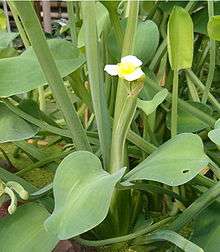Limnocharis flava
| Yellow Velvetleaf Yellow Burr Head ตาลปัตรฤาษี Kèo nèo or cù nèo 黄花蔺 huang hua lin ผักพาย ត្រកៀតប៉ោង | |
|---|---|
 | |
| Scientific classification | |
| Kingdom: | Plantae |
| (unranked): | Angiosperms |
| (unranked): | Monocots |
| Order: | Alismatales |
| Family: | Alismataceae |
| Genus: | Limnocharis |
| Species: | L. flava |
| Binomial name | |
| Limnocharis flava (L.) Buchenau | |
| Synonyms[1] | |
| |
Limnocharis flava (English: yellow sawah lettuce, yellow burr head or yellow velvetleaf, Indonesian: genjer, Javanese: gènjèr, Lao phak khan chong, Tagalog: cebolla de chucho, Thai: ตาลปัตรฤาษี, khmer: ត្រកៀតប៉ោង, Vietnamese: kèo nèo or cù nèo) is a species of aquatic flowering plant which is native to Mexico, Central America, South America, Cuba, Haiti and the Dominican Republic but widely naturalized in southern and southeastern Asia (India, Sri Lanka, Assam, Cambodia, Burma, Thailand, Vietnam, Indonesia, Malaysia and southern China (Guangdong, Yunnan)).[2][3]
Limnocharis flava is roughly 50 cm tall. growing in clumps. Its triangular-shaped leaves and hollow stems are glabrous. Its inflorescences have a very characteristic shape, producing three-lobed yellow flowers about 1.5 cm in diameter. The fruits are spherical. Although it is not a floating plant, its seeds are carried away by currents.[4][5]
Yellow velvetleaf grows generally wherever there is not very deep stagnant fresh water, in swampy areas. It sometimes invades rice fields where it can become a weed. As an invasive species it has become a pest in some wetlands in other parts of the world.[3][6]
As food
Traditionally this plant is an important vegetable in parts of Indonesia, Philippines, Vietnam,[7] Laos, Isan (Thailand)[8] and parts of India, where the central flower stalk and the leaves are used in soups, curries, salads and stir-fries.[9] The immature flower buds are also eaten. Owing to its flat taste, in some areas it is considered "poor people's food" or emergency food, eaten whenever there is not much else left. This characteristic was put into song by Muhammad Arief, in the 1940s hit Genjer-genjer in the Banyuwangi language in Java.[10]
In Thailand it is also known as phak khan chong. In Isan the Limnocharis flava leaf is eaten raw with nam phrik. It is known as phak phaai (ผักพาย) with a long "ā" sound, not to be confused with phak phai (ผักไผ่), the leaves of Persicaria odorata, another type of edible leaf.[11]
See also
- List of plants with edible leaves
- Thai cuisine
- Lao cuisine
- Indonesian cuisine
- Javanese cuisine
- List of Thai ingredients
- List of freshwater aquarium plant species
References
- ↑ The Plant List
- ↑ Kew World Checklist of Selected Plant Families, Limnocharis flava
- 1 2 Flora of China v 23 p 89, Limnocharis flava
- ↑ ISSG - L. flava
- ↑ Buchenau, Franz Georg Philipp. 1868. Abhandlungen herausgegeben vom Naturwissenschaftlichen Vereine zu Bremen 2: 2,4. Limnocharis flava
- ↑ Environmental Pests- Australia
- ↑ Micronutrient composition and nutritional importance of gathered vegetables in Vietnam
- ↑ Thailand Illustrated - Healthy Food
- ↑ Stir-Fried Genjer (Limnocharis Flava)
- ↑ Gendjer Gendjer
- ↑ New Thai Plant name index
External links
| Wikimedia Commons has media related to Limnocharis flava. |
- Encyclopedia of Life - Limnocharis flava
- Vegetables, spices and fruits of Thailand
- FAO - Aquatic plants for human food
- Thai biodiversity - Limnocharis flava